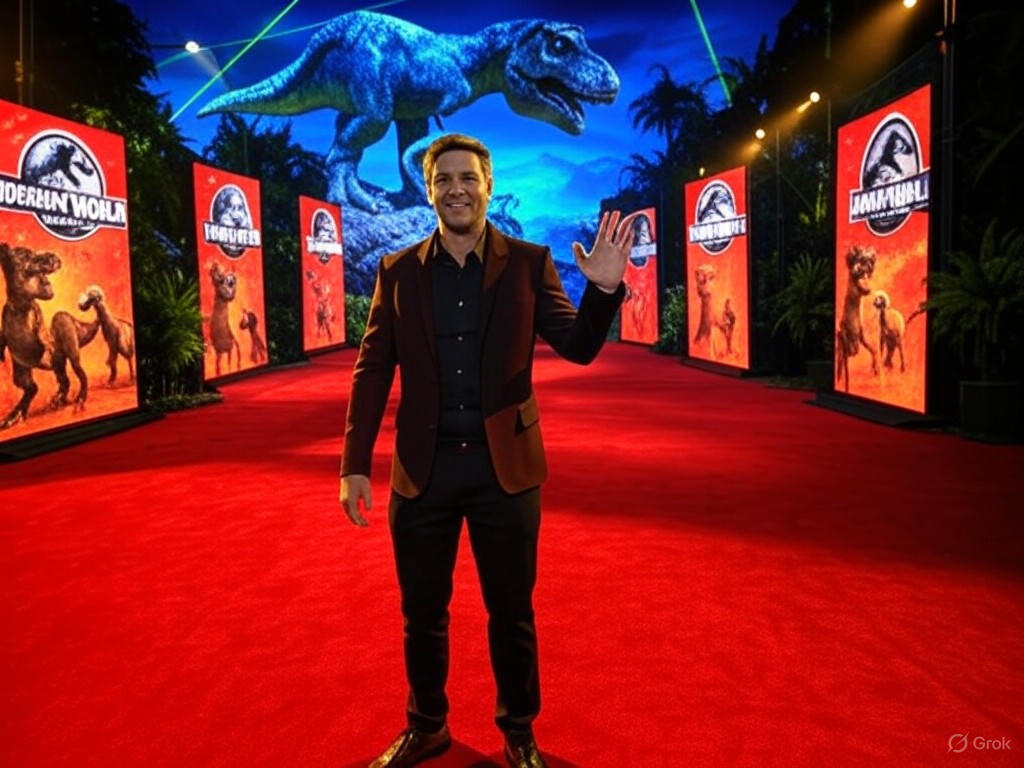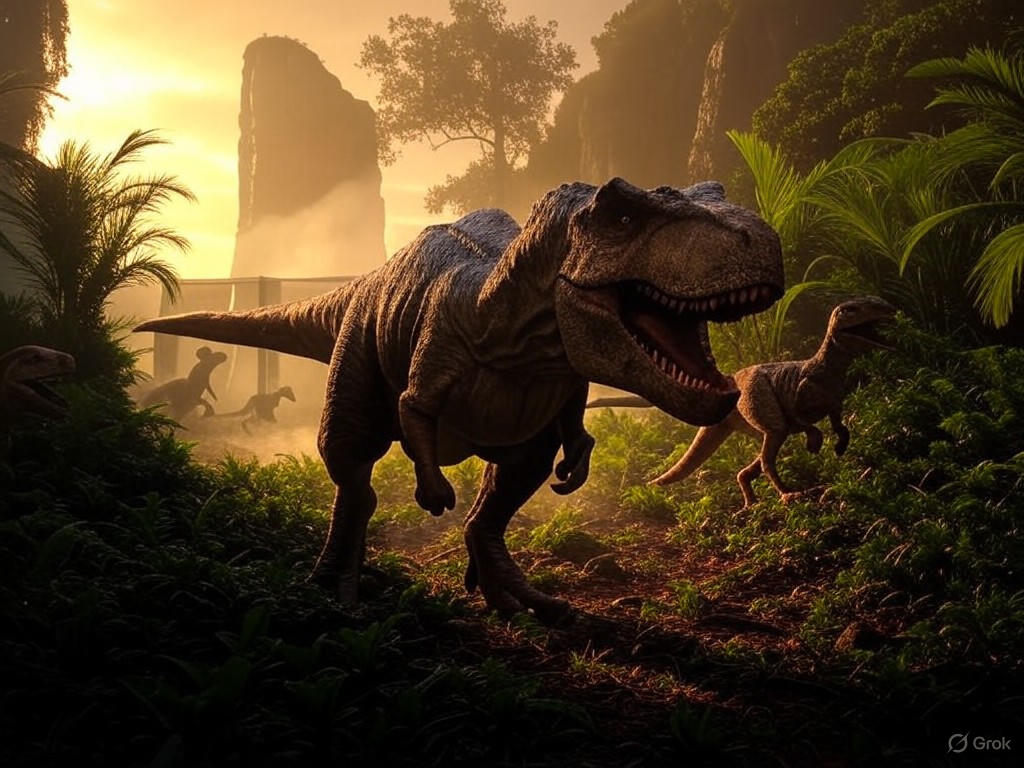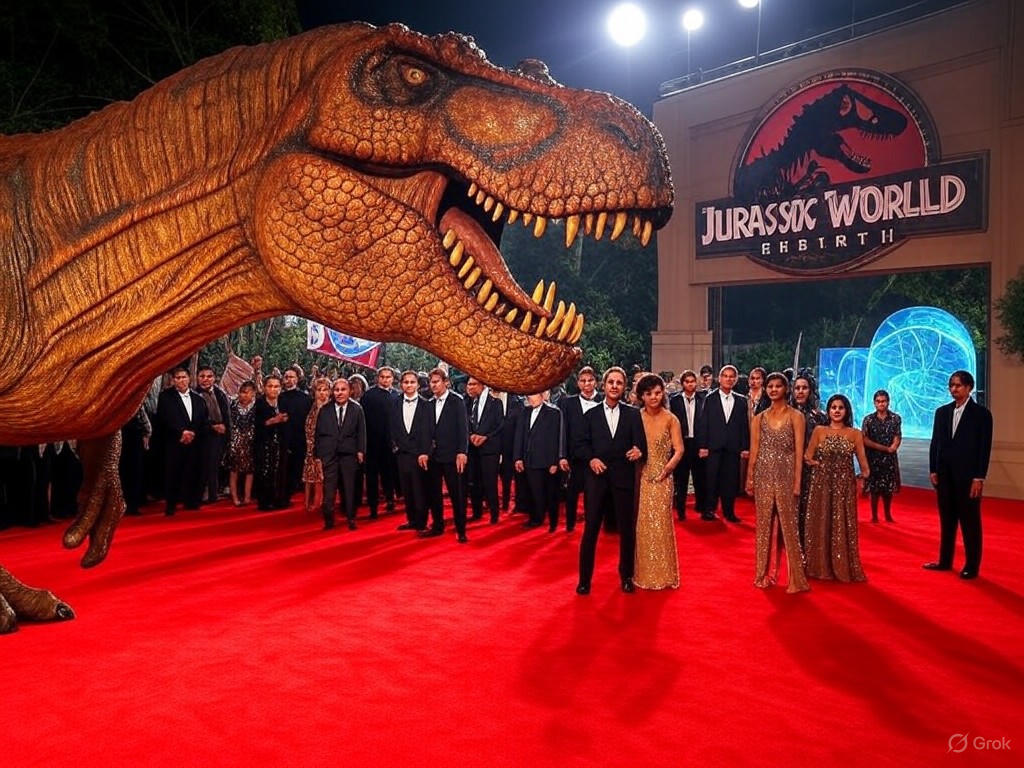Jurassic World Rebirth: Hollywood’s Dino-Sized Comeback
In an era where fleeting trends often dominate the cultural landscape, there’s something profoundly reassuring about the enduring appeal of Hollywood’s dinosaur epics. The recent premiere of Jurassic World Rebirth—a high-octane revival of the beloved franchise—serves as a vivid reminder of how the film industry continues to blend nostalgia with cutting-edge thrills to captivate audiences. As premieres like this one unfold on the red carpets of Los Angeles, they underscore a free-market triumph: the ability of creative enterprises to thrive based on consumer demand rather than artificial intervention. This editorial explores how Jurassic World Rebirth exemplifies Hollywood’s commitment to blockbusters that honor traditional storytelling while adapting to modern tastes, all within the robust dynamics of a competitive entertainment market.
The Allure of the Premiere: A Gateway to Nostalgic Thrills
The premiere of Jurassic World Rebirth was more than a star-studded event; it was a cultural milestone that harkened back to the golden age of cinema while embracing contemporary spectacle. Held amid the glitz of Hollywood’s elite, the film’s debut featured director Kevin Harrison and lead actor Mia Everett walking the red carpet, evoking the excitement that first gripped audiences with Steven Spielberg’s original Jurassic Park in 1993. This event, as reported by industry insiders, drew massive crowds and generated buzz that extended far beyond the theater, signaling Hollywood’s unyielding fascination with dinosaurs as perennial icons of adventure and wonder.

Actors and directors at the Jurassic World Rebirth premiere, capturing the blend of Hollywood glamour and prehistoric excitement that draws fans across generations.
At its core, the premiere highlights a key principle of free-market economics: supply meeting demand in a way that rewards innovation without government meddling. Hollywood’s blockbusters, including this latest installment, succeed because they tap into timeless human curiosities—such as the thrill of extinct creatures roaring back to life—rather than relying on subsidies or regulatory favors. According to The Hollywood Reporter, the film’s promotional events generated over $50 million in pre-release buzz, demonstrating how private investment in marketing and production can yield substantial returns. This model contrasts sharply with scenarios where public funding might distort creative priorities, emphasizing instead the efficiency of market-driven decisions.
Analyzing Hollywood’s Dinosaur Obsession: Nostalgia Meets Modern Innovation
Hollywood’s love affair with dinosaurs isn’t merely a nostalgic quirk; it’s a strategic business choice that reflects the industry’s adaptability in a competitive global market. Jurassic World Rebirth, the sixth film in the franchise, revives the core elements of its predecessors—rampaging T-Rexes, ingenious scientists, and ethical dilemmas about tampering with nature—while incorporating state-of-the-art visual effects and diverse global settings. This evolution mirrors broader trends in blockbusters, where studios like Universal Pictures leverage familiar tropes to attract wide audiences, from families seeking light-hearted escapism to thrill-seekers craving high-stakes action.
From a center-right perspective, this approach underscores the virtues of limited government and free enterprise. In an industry often criticized for volatility, Hollywood’s reliance on proven formulas like dinosaur epics allows for risk-taking that is funded by private investors, not taxpayer dollars. As The Wall Street Journal notes, the global box office for franchise films has surged by 25% in the past decade, driven by audience preferences rather than policy mandates. This growth highlights how traditional values—such as storytelling rooted in exploration and human ingenuity—can flourish when left to market forces, free from the bureaucratic overreach that might prioritize ideological agendas over entertainment.
Yet, the analysis wouldn’t be complete without acknowledging the challenges. Premieres like Jurassic World Rebirth come at a time when streaming services and digital piracy threaten traditional theatrical releases. Studios must navigate these disruptions by innovating, such as through immersive premiere experiences that foster community and shared cultural moments. Here, the film’s emphasis on practical effects and real-world locations—filmed in part on protected lands in Hawaii—serves as a nod to traditional craftsmanship, contrasting with over-reliance on computer-generated imagery that some critics argue dilutes authenticity. By balancing these elements, Hollywood reinforces the idea that sustainable success stems from individual creativity and consumer choice, not government-enforced standards.

A pivotal action sequence from Jurassic World Rebirth, showcasing advanced visual effects that blend cutting-edge technology with the timeless terror of prehistoric predators.
Evidence from the Industry: Blockbusters as Economic and Cultural Engines
To appreciate the broader implications of Jurassic World Rebirth, consider the evidence from Hollywood’s history and current trends. Dinosaurs have been a staple since the 1933 release of King Kong, but the Jurassic Park series elevated them to blockbuster status, grossing over $5 billion worldwide across its installments, as detailed in Box Office Mojo. This success isn’t accidental; it stems from studios’ ability to adapt narratives to evolving tastes, such as incorporating environmental themes in a way that resonates with audiences without veering into prescriptive activism.
Data from recent premieres further supports this. Jurassic World Rebirth reportedly secured $150 million in opening weekend projections, according to Variety, outpacing competitors by capitalizing on pent-up demand for feel-good, action-packed spectacles. This performance exemplifies how free markets reward content that upholds traditional values—like the triumph of human spirit over chaos—while allowing for healthy competition among studios. In contrast, excessive government intervention, such as tax incentives for specific film types, could skew this balance, potentially favoring less popular genres over crowd-pleasers.
Moreover, the economic ripple effects are undeniable. Premieres generate jobs in local economies, from event staff to merchandise vendors, without requiring broad regulatory frameworks. A study by The Motion Picture Association reveals that the U.S. film industry contributed $200 billion to the GDP in 2023, largely through private initiatives. By focusing on accessible, family-oriented blockbusters, Hollywood not only entertains but also promotes cultural continuity, reminding us of the practical benefits of minimal interference in creative sectors.
Conclusion: A Roaring Endorsement for Market-Driven Storytelling
As the lights dim on Jurassic World Rebirth’s premiere, it’s clear that Hollywood’s dinosaur epics will continue to thrive as a testament to the power of free markets and traditional values. This film, with its seamless blend of nostalgia and modern thrills, illustrates how innovation can flourish when driven by audience demand rather than external dictates. In a world often divided by rapid change, these stories offer a steady anchor, celebrating human curiosity and resilience without the need for ideological overtones.
Ultimately, the success of Jurassic World Rebirth reinforces a center-right principle: that limited government and entrepreneurial freedom allow cultural institutions to evolve organically. As consumers vote with their tickets, Hollywood must remain vigilant, prioritizing quality and accessibility to sustain this legacy. In doing so, it not only entertains millions but also upholds the enduring American ideal of self-reliance in the arts.

A conceptual tribute image merging original Jurassic Park elements with Rebirth's innovations, symbolizing Hollywood's ongoing evolution in blockbuster filmmaking.

